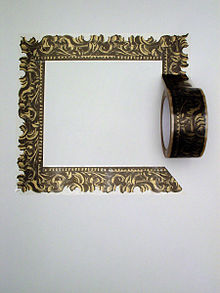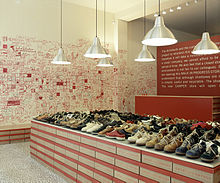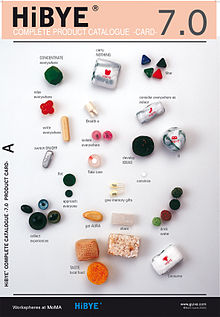- Marti Guixé
-
Marti Guixé (1964- ) is a Spanish designer living in Barcelona and Berlin. He graduated in interior design from Elisava in Barcelona in 1985 and enrolled in an industrial design study program in Scuola Polytecnica di Design di Milano in 1986. In 2001, as a statement against the limited scope of the traditional designer and to open new possibilities for the industry Guixé started an ex-designer movement, defining himself by the same name.
Contents
Concept
Guixé is very outspoken in his dislike of design as stylized object and form. Rather than reshaping existing products Guixé’s work claims to alter ways of seeing and thinking. Design to Guixé needs to evoke constant evaluation of the parameters of function and active engagement and reinvention on the part of the consumer. It should be firmly rooted in contemporary experience and not linger in past structures of functionality. Because of this critical and provocative attitude his work is sometimes associated with the critical design movement, popularized by Fiona Raby and Anthony Dunne, but in general is more playful and less moralistic.
His non-objective approach is reflected in the frequent use of disposable or cheap materials and the quick and ephemeral character of much of his work. The final design often seems only one outcome of innumerable possibilities.
There are several products in which the shape is not important and the function is more important. I think the way to do that is working basically with ideas, so that the shapes and materials become anecdotal.
Design as platform
An integrated part of Guixés conceptual approach is his interest in design as a platform for questioning, visualising and influencing contemporary human behaviour. With a focus on patterns of consumption, exchange of information and the process of choice.
We will see a growth in the number of consumer-curators, personal consumer assistants or, speaking of information, interactive consumption interfaces. What is actually happening at the moment is that some of the people doing this are becoming the brand. It is the interface that is supposed to give you confidence in what you consume and not so much the product.
As a consequence the designer's obligation is not just towards the design itself but to how it becomes part of systems of consumption.
Food Design
Guixés sensitivity towards materials that are quick, readily available and oriented towards mass consumption led him to become an important innovator in food design. He understood food design as a way to re-evaluate and redesign the structure around food, the industry and the consumer. Void from nostalgia, food for Guixé is primarily an edible designed product, an object that negates any reference to cooking, tradition and gastronomy.
I am only interested in food, as I consider it is a mass consumption product and I like the fact that it is a product that disappears – by ingestion – and is transformed into energy.
For many years food has no longer been a necessity but a consumer product.
Most of my food projects are not commercial, but are a way of defining a new perception of this kind of product.
Commercial work
In spite of his critical attitude Guixé designs products because, as he claims himself, he needs them. Among his clients are:Alessi, Authentics, B-sign, Camper, Cha-cha, Chupa Chups, Corraini, Danese, Dentsu, Desigual, Drill, Droog Design, Esencial Mediterraneo, Galeria H2O Barcelona, Imaginarium, Isee2, Kesselskramer, Mediamatic, Magis, Nani Marquina, Rome Film Festival, Saporiti Italia, Trico, Very Lustre, Vitra, Watx.
Non-commercial work
Guixés work already early in his career aroused the interest of the art field. His designs, installations and performances have been shown in many international group shows as well as solo projects, Among them MOMA, Centre Georges Pompidou, Design Museum London, Centre d'Art Contemporain Genève, National Art Center Tokyo, Museum für angewandte Kunst.
Books
- Fish Futures (ISBN 84-921103-2-5) 1998
- Martí Guixé 1:1 (ISBN 90 6450 441 5) 2002
- Food Design (ISBN 84-932554-0-8) 2003
- Context free, including the Kitchen Buildings (ISBN 3-7643-2422-8) 2003
- Martí Guixé, Cook Book (ISBN 9077362045) 2004
- Toy Weapons, user manual (ISBN 88-7570-071-0) 2005
- Don't buy it if you don't need it. All Marti Guixe's Camper Commodityscapes. (ISBN 84 609 9135 0) 2007
- Blank Book (ISBN 978-88-7570-137-6) 2007
Awards
- INFAD medal of interior design (1985)
- Ciutat de Barcelona Design Price (1999)
- 1st price Expohogar with Plant-me pets. (2003)
- Design Plus award, for the Plant-me pets. Frankfurt Ambiente. (2004)
- Useful and Agreeable Design Award, Vancouver, Canada (2004)
- Honorable mention to FoodBALL, Travel and Leisure Design Award, USA (2006)
- National Design Price of the Generalitat de Catalunya (2007)
External links
- Marti Guixé's official website
- Marti Guixé's food design
- Ex-designer website
- Marti Guixé's gallery in Berlin
- Marti Guixé at Design Museum London
- /Marti Guixé at Useful and Agreeable
- Documentation of all Marti Guixé's work since 1997
- ex-designer, young urbanist and architist philosophising about lies, a podcast by ar2com - architecture to communications published 11/01/17
See also
Categories:- 1964 births
- Living people
- Spanish industrial designers
Wikimedia Foundation. 2010.



